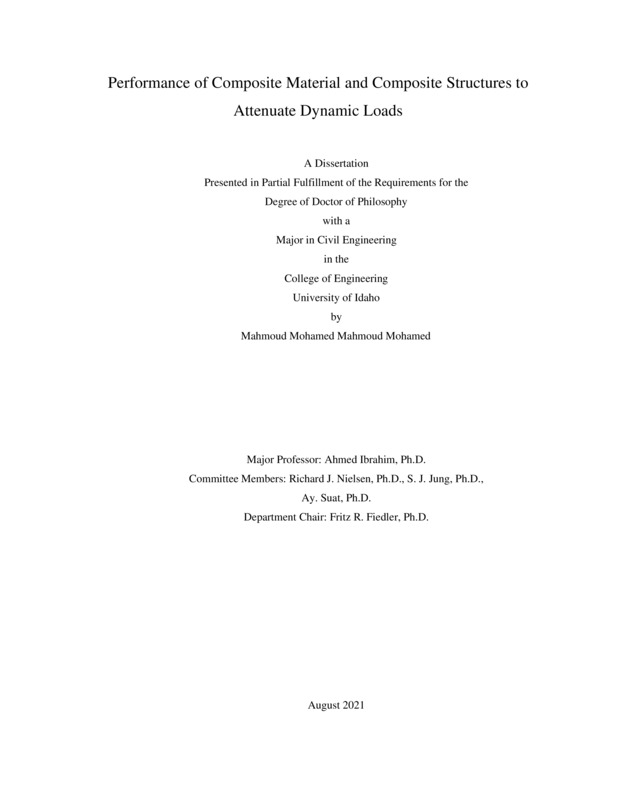PERFORMANCE OF COMPOSITE MATERIAL AND COMPOSITE STRUCTURES TO ATTENUATE DYNAMIC LOADS
Mohamed, Mahmoud Mohamed Mahmoud. (2021-08). PERFORMANCE OF COMPOSITE MATERIAL AND COMPOSITE STRUCTURES TO ATTENUATE DYNAMIC LOADS. Theses and Dissertations Collection, University of Idaho Library Digital Collections. https://www.lib.uidaho.edu/digital/etd/items/mohamed_idaho_0089e_12154.html
- Title:
- PERFORMANCE OF COMPOSITE MATERIAL AND COMPOSITE STRUCTURES TO ATTENUATE DYNAMIC LOADS
- Author:
- Mohamed, Mahmoud Mohamed Mahmoud
- ORCID:
- https://orcid.org/0000-0002-5992-0966
- Date:
- 2021-08
- Keywords:
- Blast loading Composite material Composite structure Crashworthiness Dynamic behaviour Finite element analysis
- Program:
- Civil Engineering
- Subject Category:
- Civil engineering
- Abstract:
-
Protecting structures against accidental or intentional blast events is a sophisticated task in structural engineering. If vital civilian critical structures (buildings, bridges, embassies, etc.) are threatened, the main concern lies in developing an effective rescue plan and rapid intervention. The integrity of the structure itself is rarely considered. However, explosion events devasting civilian buildings and structures have been increased during the last few decades (bomb attacks World Trade Centre (1993), Oklahoma (1995), US embassy Kenya (1998), sugar factory explosion in Georgia (2008), Beirut (2020)), to name a few. Consequently, shielding structures against blast hazards has become an active area for research for many years. Numerous efforts were devoted to suggesting appropriate solutions to this problem. Among these solutions, sandwich panels providing a quite promising approach for blast mitigation techniques for their high strength, lightweight, and superb energy absorption capabilities compared with single metallic plates with equivalent weight. Sandwich panels typically have three layers; two outer plates made of metals or composite materials and a core layer in-between. The plate facing blast wave distributes the blast pressure uniformly among the core layer, which progressively deforms and absorbs a large amount of blast energy, thus the pressure transferred to the structure is attenuated. The efficiency of these sacrificial layers depends mainly on the quantity of energy absorbed by their core. This research aimed to improve the blast performance of sandwich structures by introducing novel core layers that can absorb an enormous amount of energy. This research presents an innovative energy absorbing component applicable to energy absorption applications. The developed structure comprises a superposition of two different energy absorption techniques to enhance the energy absorption capacity of a novel core structure. The proposed core structure can be applied to extensive blast-resistant and crash-worthiness applications. Thus, experimental and numerical investigations have been conducted to investigate the influence of applying internal stiffeners and staking composite layers on the behavior of aluminum (AL) thin-walled tubes. Single, double, and quadruple thin-walled metallic and hybrid tubes were tested under axial quasi-static compression test. The specimens were fabricated from unidirectional CFRP, epoxy resin, and aluminum alloy T6061-T6. Various crashworthiness parameters were assessed, such as the absorbed crash energy, specific energy absorption, crush force efficiency, average crushing load, and peak load absorbed to highlight the effectiveness of the novel configurations. The hybrid quadrable multi-cell structure showed the highest energy absorption capabilities between the other proposed configurations. Its energy absorption improved by 116% compared to the solo hollow AL tube. In addition, nonlinear finite element analysis (FEA) using the commercial ANSYS/LS-DYNA Workbench software was utilized to verify the experimental results. Numerical simulations show a proper verification with the experimental results as the discrepancy percentage for the energy absorption varied between 4.14 to 10.69 and 3.41 to 8.30 for the peak crushing force. The hybrid multi-cell tubes were adopted in a sacrificial cladding structure to enhance the blast performance of reinforced concrete panels. This research also presents a new core topology for sandwich structures named ribbon core configuration. The purpose of this configuration is to provide a sandwich structure with the following advantages: very light, less expensive, simple to manufacture, great flexibility, and the curvature could be constructed in the two directions. The dynamic performing of the new shape numerically investigated for metallic sandwich structure panels exposed to blast loading. The FE models’ accuracy was verified using experimental results that can be accessed in the literature that used trapezoidal corrugated core configurations. Results express that the conducted finite element models are dependably utilized to simulate the dynamic behavior of the sandwich structure under the impact of the blast loading. The ribbon-core sandwich panel (RCSP) blast behavior and trapezoidal corrugated-core sandwich panel (TCCSP) were compared. The results imply that RCSP experienced superior blast resistance than the TCCSP. Findings were used as a guideline for designing sandwich structures under the impact of blast loading.
- Description:
- doctoral, Ph.D., Civil Engineering -- University of Idaho - College of Graduate Studies, 2021-08
- Major Professor:
- Ibrahim, Ahmed
- Committee:
- Ay, Suat; Jung, S.; Nielsen, Richard
- Defense Date:
- 2021-08
- Identifier:
- Mohamed_idaho_0089E_12154
- Type:
- Text
- Format Original:
- Format:
- application/pdf
- Rights:
- In Copyright - Educational Use Permitted. For more information, please contact University of Idaho Library Special Collections and Archives Department at libspec@uidaho.edu.
- Standardized Rights:
- http://rightsstatements.org/vocab/InC-EDU/1.0/

